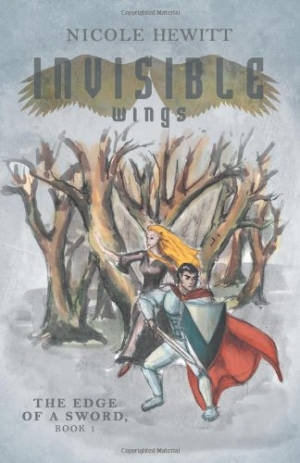Invisible Wings
Riveting, entertaining action elevates character-development and themes of light and dark in this experimental fantasy.
Invisible Wings contains all of the elements needed to make a medieval fantasy: elves, fairies, dragons, kingdoms, and rogues, as well as a theme of good versus evil, or, in this case, Light versus Shadow. Nicole Hewitt makes the story come alive.
Lady Sylvia Gruith, the last of a species known as elvin-fairies, had become tainted with Shadow during the destruction of her father’s kingdom. Taken captive shortly thereafter and severely abused, she manages to escape and find shelter in an inn, where she meets a three-person troupe. Upon hearing Sylvia’s tales of woe, the trio insists she join them, both to find someone to make her whole again and to use her magical Light powers to overthrow the Shadow. And thus, as the foursome begin their perilous adventures, romance enters the picture for the main protagonists, Sylvia and Derik, one of the other band members.
In the first quarter of this debut novel, the narrative appears to be heading in a good direction, and Hewitt does a fairly good job of creating an interesting plot with a strong overarching skeletal design that includes rich character development. Complementary to this is the use of third-person omniscient view, which reflects the mind-set of a world where men find their worth in valor and domination and women struggle for survival in a male-dominated society. In this case, Sylvia fights for her aristocratic status.
The midsection of the book, however, is filled with several problems that quickly bog down the story line. There are a number of typos and run-on sentences; the occurrence of the latter is frequent enough to impede the flow of the narrative. For example, “She suppressed a shiver and raised her eyes cautiously to look at her box, she dared not lie in case he saw through it, if she did he might steal box back.”
Although the book seamlessly segues from one scene to another, many sections are clogged with tedious filler that does not contribute to the story. For example, a great deal of time is devoted to Sylvia’s horrendous experiences in captivity, which are worth mentioning but do not build up to any future event in the narrative. When Sylvia performs healing spells on herself, she repeatedly passes out, which could offer comic relief; instead, pages are unnecessarily filled with Derik’s agonizing thoughts on Sylvia’s misfortune. The incorporation of a thieving elf in the plot’s twist makes for a great addition, except for the fact that his two-time appearance doesn’t seem to tie into the narrative. Finally, the inclusion of rhyming couplets in the dragon scenes is both clever and a welcoming nuance, but it quickly loses its flavor after several pages of monotonous poetry.
The last quarter of Invisible Wings is radically different from the rest of the book. With better grammar and punctuation, the narrative shifts from ennui to pure entertainment. Riveting action is juxtaposed with events that are interwoven with the type of humor befitting a Johnny Depp movie; plus it closes with a great cliffhanger.
The cover art is tasteful but would benefit from a bolder, more dramatic design to reflect the narrative’s dark medieval theme. Even so, Invisible Wings has the potential to grow into a series.
Reviewed by
Anita Lock
Disclosure: This article is not an endorsement, but a review. The publisher of this book provided free copies of the book and paid a small fee to have their book reviewed by a professional reviewer. Foreword Reviews and Clarion Reviews make no guarantee that the publisher will receive a positive review. Foreword Magazine, Inc. is disclosing this in accordance with the Federal Trade Commission’s 16 CFR, Part 255.

